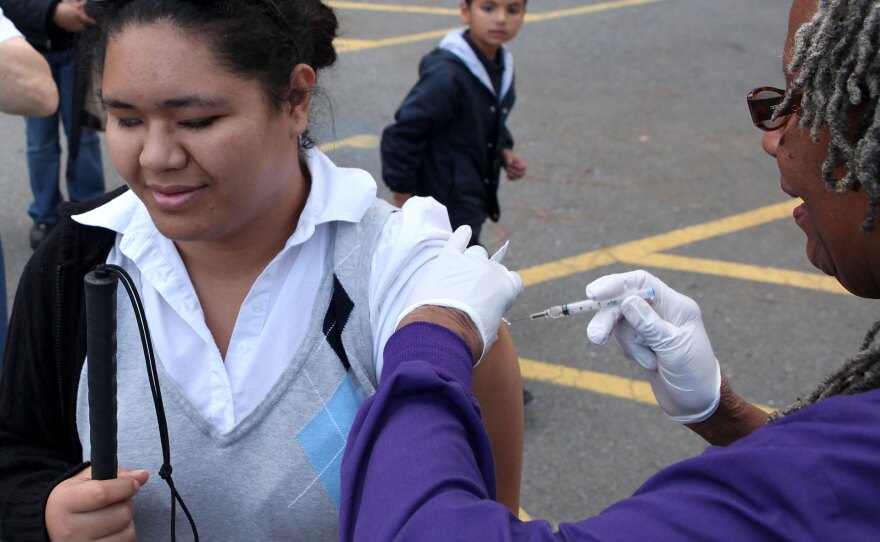As the shortage of vaccinations against the new H1N1 swine flu begins to lessen, researchers are working to find ways to prevent flu vaccine shortages from occurring again.
They're looking for new ways to make flu vaccines. The old way, in use for more than 50 years, involves growing inside of chicken eggs a modified form of whatever flu virus is in circulation. The viruses replicate and can be harvested from the eggs. The process of vaccine development and production takes about five months.
According to Bill Hall, a spokesman for the Department of Health and Human Services, the government has spent nearly $2 billion in the past five years on developing quicker, eggless systems.
Egg Method Too Slow
Even if you yell at them, they don't grow faster.
It's a process that Congress is watching closely. Last week, at several hearings on H1N1, lawmakers castigated scientists and planners for not having anything on hand. Democratic Rep. Diana DeGette of Colorado said, "We've got to fix this problem. We can't wait till we have another pandemic before we get an alternative to egg-based vaccines."
It's not for lack of trying. At a recent news conference, Thomas Frieden, director of the Centers for Disease Control and Prevention, said there's a problem with the viruses growing in the eggs. "Even if you yell at them, they don't grow faster."
Newer, Faster Techniques
What academic and drug company researchers are trying to do is simple, on paper. Flu viruses are basically genetic material, or DNA, surrounded by a protein coat. The researchers are looking for a protein in the virus coat that the human body will recognize as foreign, so that when the protein is introduced into the body, the immune system will take notice. The next time your immune system sees that protein — say, after someone nearby coughs and you inhale the virus — it will be ready to attack the protein, and thus the virus.
Coming up with the protein, though, involves some pretty sophisticated science, says Anthony Fauci, head of the National Institute of Allergy and Infectious Diseases, which has funded much of the research.
Using The Virus' DNA
There are multiple lines of research going on. Several rely on identifying a piece of the virus' genetic material that carries the instructions for building a protein on the coat of the virus.
And then, says Fauci, "You take a harmless virus, and you engineer into it the gene that is coding for the appropriate influenza protein." Then you use that recombinant virus as a vaccine — it "shows" the protein to the immune system, so that the immune system will recognize it the next time it sees it.
Or, a recombinant virus can be grown in cell cultures, and the protein can be harvested.
In another approach, researchers are trying "naked DNA" — injecting just the genetic instructions for a flu virus protein into people, whose cells take up the DNA and begin producing the protein. "Those genes start to code and make the protein that you want to make an immune response to," Fauci says. So, your own cells manufacture the protein. No yelling at eggs, and no worries about egg allergies.
And some researchers are trying to do the work of the DNA on their own, just building the protein from chemicals in the lab.
Universal Flu Vaccine
The ultimate dream is finding a protein that doesn't change from flu virus to flu virus. Flu viruses change a little every year — that's why annual vaccines are needed. Finding a "universal" protein would mean there'd be no need for a new flu vaccine every year. "We're not anywhere near close to that, but the concepts are starting to fall into place," Fauci says.
One thing the effort needs is time, says Robert Couch, a virus expert at the Baylor College of Medicine in Houston. "Nothing is done very rapidly in these systems because so much time is required for developing, for evaluating safety, for doing the manufacturing systems that are optimal," he says.
Growing viruses and cells in culture can be difficult. And then there's the review process. The Food and Drug Administration is likely to be cautious about such new technologies.
Couch has been helping Protein Sciences, the manufacturer of the product that's furthest along — a vaccine made in insect cells. Last week, the vaccine was considered by an FDA advisory committee. The committee gave it mixed reviews, saying the vaccine appears to be effective in 18- to 49-year-olds, but needs more safety testing. Protein Sciences CEO Daniel Adams says that he thinks the committee was unduly pessimistic, and that he'll press forward with the approach.
Copyright 2022 NPR. To see more, visit https://www.npr.org. 9(MDAzMjM2NDYzMDEyMzc1Njk5NjAxNzY3OQ001))







